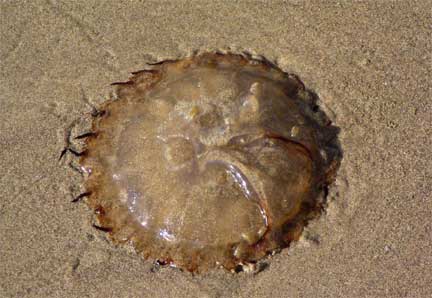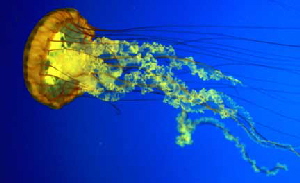|
Two common jellyfishes wash ashore during fall and winter, the Pacific sea nettle, Chrysaora fuscescens, and the larger moon jellyfish Aurelia aurita. Both are in the class Scyphozoa, large jellyfish with  long, frilly but fragile oral arms that extend from the mouth and drape below the bell. Scyphozoans have no vellum, a membrane that encircles the inside of the margin of the bell of other jellyfish in the class Hydrozoa. What you see on beach is mainly the gelatinous, dome-shaped bell, flattened because it has washed ashore and is no longer buoyed by water, and you may see some tentacles extending from the bell’s edge. In the water these are handsome creatures, their oral arms and tentacles trailing many feet behind the bell that slowly pulsates with rhythmic contractions. Jellyfish are considered part of the plankton because their ability to swim is limited and they mainly drift with the current. long, frilly but fragile oral arms that extend from the mouth and drape below the bell. Scyphozoans have no vellum, a membrane that encircles the inside of the margin of the bell of other jellyfish in the class Hydrozoa. What you see on beach is mainly the gelatinous, dome-shaped bell, flattened because it has washed ashore and is no longer buoyed by water, and you may see some tentacles extending from the bell’s edge. In the water these are handsome creatures, their oral arms and tentacles trailing many feet behind the bell that slowly pulsates with rhythmic contractions. Jellyfish are considered part of the plankton because their ability to swim is limited and they mainly drift with the current.
Chrysaora has a lovely golden-brown bell and 24 dark brown tentacles equipped with potent stinging cells (nematocysts) that rim the edge. Its  white oral arms and many of the tentacles are almost always lost from individuals that have been pummeled in the surf then stranded on shore. It is reputed to have a vicious sting and should be avoided. They, as other jellyfish, are carnivorous and use these stinging cells to capture prey, including small fish, other jelly fish, ctenophores, marine eggs and larvae, any animal of appropriate size. Chrysaora may form dense offshore swarms that wash onto the beach. A related species, C. melanogaster, which has 16 radiating dark streaks on the bell, may occasionally wash ashore. white oral arms and many of the tentacles are almost always lost from individuals that have been pummeled in the surf then stranded on shore. It is reputed to have a vicious sting and should be avoided. They, as other jellyfish, are carnivorous and use these stinging cells to capture prey, including small fish, other jelly fish, ctenophores, marine eggs and larvae, any animal of appropriate size. Chrysaora may form dense offshore swarms that wash onto the beach. A related species, C. melanogaster, which has 16 radiating dark streaks on the bell, may occasionally wash ashore.
|

